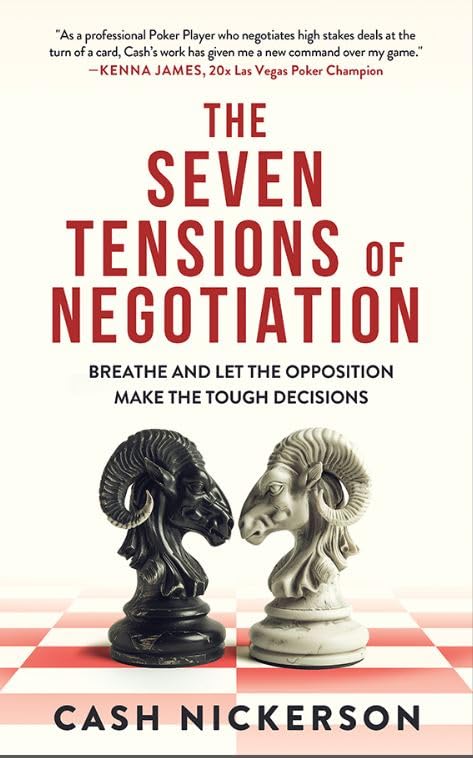We humans engage in negotiations whether we want to or not — for a salary increase, for what the price we’ll pay for a car, for how we’ll split belongings in a breakup, and so on. For most of us, entering into a negotiation is enough to get our heart racing. The tension we feel in a negotiation, and what to do about it, is the subject of master negotiator Cash Nickerson’s illuminating new book, The Seven Tensions of Negotiation.
Nickerson has broken down the types of tensions that surface before and during negotiations to seven forms:
1-Relationship tension that involves whether the parties know each other or will need to maintain a relationship after the negotiation’s outcome — such as having to work together after a merger;
2-Outcome tension that relates to what sacrifices may have to be made;
3-Process tension regarding who makes the ground rules about location, order matters are addressed, and so on;
4-Timing tension reflecting how quickly or not a party needs to resolve the issue;
5-Power tension that involves who has more ability to influence the negotiation;
6-Agent tension when an intermediary is hired to conduct the negotiation and how well this person will represent you;
7-Team tension that arises when the negotiation is conducted by a team of constituents.
With so many tensions to navigate, Nickerson shares how to not only manage and conquer, but also leverage the tensions that emerge to one’s advantage.
His anecdote early in the book to illustrate the most basic of negotiations — how to divide a Snickers bar between two parties — reveals the many layers of strategy that go into even the most commonplace negotiation. Then, throughout the book, he drives home his points through numerous edifying examples of negotiations in which he’s been involved over his career as a corporate lawyer, a business executive, a CFO and a CEO. From the high-stakes to negotiating the price of a scarf in Istanbul’s Grand Bazaar, Nickerson shows how to put the tensions into practice.
Nickerson, who has taught negotiation to law students at Washington University School of Law, explains why he believes the collaborative approach to negotiation, billed as principled negotiation and often taught in academic settings, falls short. Trying to remove tension from the negotiation process, he says, is a utopian pipedream.
A particularly compelling chapter analyzes the negotiation favored tensions employed by political leaders, from US presidents Donald Trump and Jimmy Carter, to dictators like Vladimir Putin, Xi Jinping, and Kim Jong Un (power negotiation archetypes). Nickerson warns, “If you try to approach Donald Trump (relationship negotiator) as if he were Jimmy Carter (outcome and process negotiator), you are going to put him to sleep. Likewise, if you try to reason with a power negotiator, you will be disappointed and confused when he or she attacks you.”
The Seven Tensions of Negotiations will help you come to any negotiation with more confidence as you recognize and are better able to deal with the tensions that arise. At the same time, Nickerson’s story-telling approach to punctuating his tactics make the book an entertaining read.
Learn more at cashnickerson.com.
Garth Thomas

